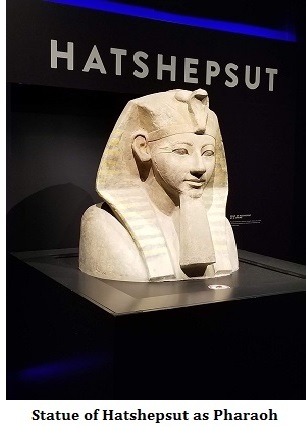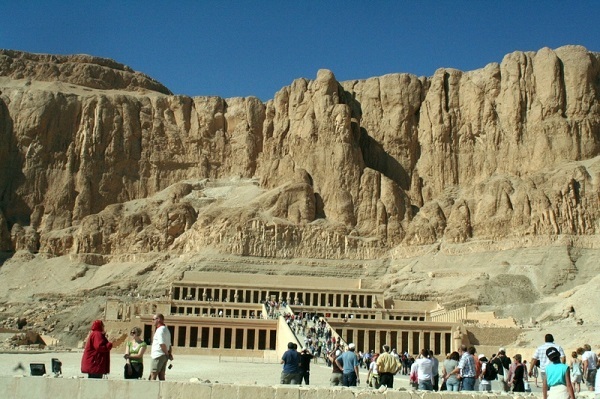

 Hatshepsut was a female pharaoh of Egypt who reigned during the 18th dynasty. She was the daughter of King Thutmose I and his queen, Ahmose. Hatshepsut served as queen regent for her stepson, Thutmose III, before declaring herself pharaoh and ruling for around 20 years, from around 1473 to 1458 BCE.
Hatshepsut was a female pharaoh of Egypt who reigned during the 18th dynasty. She was the daughter of King Thutmose I and his queen, Ahmose. Hatshepsut served as queen regent for her stepson, Thutmose III, before declaring herself pharaoh and ruling for around 20 years, from around 1473 to 1458 BCE.
Hatshepsut was a successful ruler and a patron of the arts and architecture, commissioning many monumental building projects and leading military campaigns to expand Egypt's control and trade. Despite efforts by her successor, Thutmose III, to erase her legacy, Hatshepsut is now recognized as one of ancient Egypt's most successful pharaohs.
Hatshepsut was born in 1508 BCE in Egypt's 18th dynasty, as the daughter of King Thutmose I and his queen, Ahmose.
She was the eldest of her family and had one full-brother Amenmose and two half-sisters Nefrubity and Wadjmose.
She was raised in the royal court and received an education befitting a princess.
Hatshepsut was married to her half-brother Thutmose II, who became pharaoh after their father's death.
She served as queen consort and Great Royal Wife of Egypt, bearing Thutmose II a daughter named Neferure.
After Thutmose II's death, Hatshepsut served as queen regent for her stepson, Thutmose III, when he was still a child.
Hatshepsut eventually declared herself pharaoh, becoming one of the few women to hold this title in ancient Egypt. This was done by using her relation to the royal family and her position as regent, and possibly with the support of powerful officials and military leaders.
She is believed to have ruled for around 20 years, from around 1473 to 1458 BCE. During her reign she was known as Maatkare Hatshepsut, meaning "Maat is the Soul of Hatshepsut" and was depicted in official art and inscriptions wearing the pharaoh's traditional false beard and headdress.
Hatshepsut was a successful ruler and a patron of the arts and architecture. She commissioned the construction of many monumental building projects, such as the temple of Amun at Deir el-Bahri, the temple of Anubis at Wadi el-Shatt el-Rigga, and the temple of Monthu at Armant.
She also renovated and expanded many existing structures, including the temple of KarnACK and the temple of Luxor.
Hatshepsut also led several military campaigns, including one in Nubia and another in the Levant. She extended Egypt's control and trade in these regions, and brought back valuable resources such as timber and precious metals.
The military campaigns in Nubia were aimed to secure the valuable resources such as gold, ivory and incense, and also to protect Egypt from potential invasions from the south.
Hatshepsut also established diplomatic relationships with other kingdoms, including the powerful kingdom of Punt, which was a major trading partner.
Hatshepsut was also a patron of the arts, literature, and religion. She supported the construction of many temples, shrines, and statues, which helped to promote the religion of Amun and the cult of the royal family.

After the introduction of Christianity, Hatshepsut`s temple was used as a monastery, hence its modern name, Deir el-Bahri, Arabic for `Northern Monastery.` Hatshepsut was a female pharaoh who had herself represented pictorially as a male. She served as co-regent with her nephew Thutmose III c. 1479-1425 B.C.E.
Hatshepsut's rule was followed by a period of political turmoil, and her stepson, Thutmose III, who succeeded her, attempted to erase her legacy.
Many of Hatshepsut's statues and inscriptions were vandalized or destroyed, and her name was erased from official records. This was done in an attempt to legitimize Thutmose III's claim to the throne and to diminish Hatshepsut's achievements.
Hatshepsut's mortuary temple at Deir el-Bahri, however, was not destroyed, and it remained an important place of pilgrimage and cult worship throughout ancient history.
The exact details of Hatshepsut's death are unknown, but she is believed to have died in 1458 BCE. Some historians theorize that she died of natural causes, while others speculate that she may have been murdered by her stepson, Thutmose III, or by political rivals. However, there is not enough evidence to confirm the cause of death definitively.
Hatshepsut's tomb was discovered in the Valley of the Kings in 1903, and it was found to be intact and untouched by tomb robbers. The tomb contained many of her funerary goods, including a large collection of statues and jewelry, providing insight into her life and reign.
In conclusion, Hatshepsut was a remarkable figure in the history of ancient Egypt. As one of the few female pharaohs, she demonstrated her capabilities as a leader and a ruler. Her accomplishments and military campaigns expanded Egypt's power and wealth, and her building projects left a lasting architectural legacy.
Despite the attempts by her successor to erase her memory, Hatshepsut's contributions to Egypt have been rediscovered and acknowledged in modern times. Hatshepsut's rule serves as an inspiration to women everywhere, showing that they are capable of holding positions of power and making significant contributions to history.
Q1. How did Hatshepsut become pharaoh?
Ans. Hatshepsut initially served as queen regent for her stepson, Thutmose III, when he was still a child. However, she eventually declared herself pharaoh, becoming one of the few women to hold this title in ancient Egypt. It's believed that Hatshepsut may have used her position as regent and her relationship to the royal family to justify her claim to the throne.
Q2. How Hatshepsut's legacy has been rediscovered?
Ans. In the modern era, Hatshepsut's legacy has been rediscovered through archaeological discoveries and the study of historical texts. Many of the monumental buildings she commissioned still stand today, and inscriptions on these buildings have provided valuable information about her reign. Additionally, scholars have used various techniques, such as multispectral imaging, to uncover inscriptions that have been erased or covered over. Hatshepsut's legacy has also been re-evaluated from a more feminist perspective, highlighting the importance of women in history and their contributions to society.
Q3. Why did Hatshepsut's legacy face erasure?
Ans. Hatshepsut's rule was followed by a period of political turmoil, and her stepson, Thutmose III, who succeeded her, attempted to erase her legacy. Many of Hatshepsut's statues and inscriptions were vandalized or destroyed, and her name was erased from official records. Hatshepsut's mortuary temple was also used as a quarry for later building projects. This was done to legitimize Thutmose III's claim to the throne and to diminish Hatshepsut's achievements.